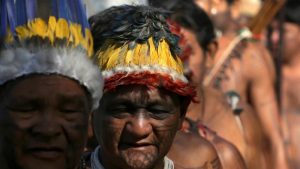
Photo of protestors taken by Eraldo Peres (Associated Press).
The last five hundreds years of history has seen in the American continents a large disregard for the rights and privileges of native peoples by colonial governments. Their very ways of life have been altered significantly to the point they will never be able to go back to the way things were prior to colonization.
In April 25th of this year an estimated 3,000 indigenous people from all across Brazil marched on the capital of Brasiliia to protest around thirty three large infrastructure and economic projects on native lands that are proposals in the Federal Congress. These projects includes dams, mining, logging, and agriculture.
They are also protesting dramatic cuts to the agency in charge of native relations (FUNAI). Their third major point of protest has been violence towards natives. A year ago it was reported dozens of members of the Gamela tribe were hospitalized after a brutal attack by local ranches. A truth commission has been set up by the federal government to investigate the deaths of around 8,000 native Americans between the years of 1946-1988. It has been reported that the number of homicides of indigenous persons is the highest since 2003 at this time.
Brazil has two hundred federally recognized tribes which have 900,000 people. The main organization leading these protests is Brazil’s Indigenous Ministry Council (CIMI). These issues surrounding ingenious Brazilians have also gained international attention recently and in the past. Greenpeace did a journalistic investigation of logging encroachment on indigenous land. The UN Environmental Office has condemed violence against Brazilian natives. Two weeks ago a member of the Karipuna tribe spoke on the floor of the UN General Assembly denouncing the treatment of natives by Brazil’s government and nationals and calling it a “Genocide”.
Link to article: https://www.aljazeera.com/news/2018/04/indigenous-brazilians-rally-demand-land-rights-protection-180425203118095.html
